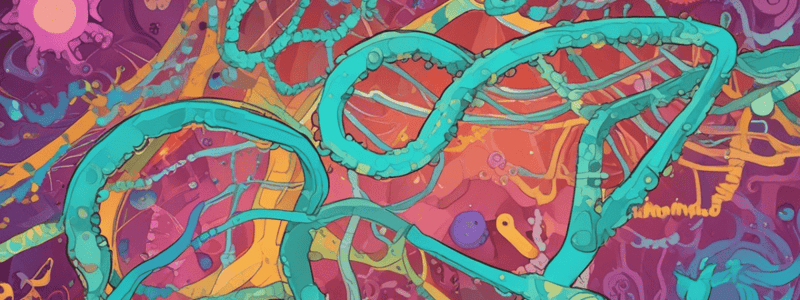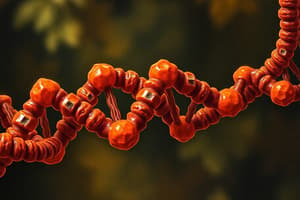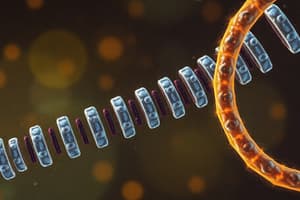Podcast
Questions and Answers
What does RNA polymerase I synthesize?
What does RNA polymerase I synthesize?
- tRNAs
- pre-ribosomal RNA (correct)
- small RNA products
- mRNA
Which RNA polymerase is responsible for the synthesis of mRNA?
Which RNA polymerase is responsible for the synthesis of mRNA?
- RNA polymerase I
- TFIIH
- RNA polymerase III
- RNA polymerase II (correct)
What is the role of TFIIF in the assembly of RNA polymerase?
What is the role of TFIIF in the assembly of RNA polymerase?
- Unwinds DNA at the promoter
- Involved in DNA melting
- Binds to RNA Pol and targets it to the promoter (correct)
- Initiates interaction with TATA-binding protein
What happens during the termination phase of transcription?
What happens during the termination phase of transcription?
Which factor releases the RNA polymerase from the promoter?
Which factor releases the RNA polymerase from the promoter?
Which of the following is NOT synthesized by RNA polymerase III?
Which of the following is NOT synthesized by RNA polymerase III?
Flashcards are hidden until you start studying
Study Notes
Eukaryotic RNA Polymerases
- RNA Polymerase I synthesizes pre-ribosomal RNA, which serves as a precursor for 28S, 18S, and 5.8 rRNAs.
- RNA Polymerase II is responsible for the synthesis of mRNA.
- RNA Polymerase III produces tRNAs and some small RNA products.
RNA Polymerase Assembly
- Assembly of RNA Polymerase is initiated by the interaction of TATA-binding protein (TBP) with the promoter.
- Two transcription factors (IIA and IIB) bind to the promoter after TBP.
- Finally, TFIIE and TFIIH bind to the promoter, with TFIIE involved in DNA melting and TFIIH possessing helicase activity to unwind DNA.
Elongation, Termination, and Release
- TFIIF remains attached to RNA Polymerase II during elongation.
- Elongation factors help increase efficiency and prevent pausing.
- They also regulate post-transcriptional processing.
- At termination, the phosphate is removed from the RNA chain.
RNA Strand Initiation and Promoter Clearance
- The kinase activity in TFIIH phosphorylates RNA Polymerase, allowing it to escape the promoter.
- Initially, 60-70 RNA nucleotides are synthesized.
- Then, TFIIE and TFIIH are released, and the process moves to elongation.
Studying That Suits You
Use AI to generate personalized quizzes and flashcards to suit your learning preferences.




